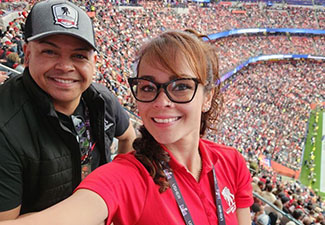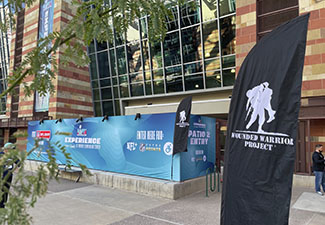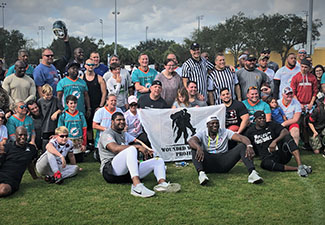Army vs. Navy: A Clash for the Ages

The annual Army-Navy game, presented by USAA, a longtime partner of Wounded Warrior Project® (WWP), is one of the most storied rivalries in college football. The game’s history dates back to 1890 and boasts plenty of patriotic storylines, jaw-dropping plays, and legendary traditions. In the 125th meeting of the two rivals on Dec. 14, 2024, the Navy Midshipmen upset the Army Black Knights 31-13 at Northwest Stadium in Landover, Maryland,.
“There aren’t two fan bases more passionate about their schools, nor two that have more respect for each other,” USAA Service Academy Relations Advisor Paul McElroy said previously about the special game. “This balance between wanting to beat each other out on the field, yet still recognizing a shared sense of commitment and service makes this one of the most sacred events in all of sports.”
Here are some other interesting facts about the renowned Army vs. Navy football history of “America’s Game:”
The Start of the Army-Navy Rivalry
The first matchup between Army and Navy took place on Nov. 29, 1890, at West Point, New York. Navy won the game 24-0 to finish its season with a 5-1-1 record. While the Midshipmen had been playing intercollegiate football since 1879, the 1890 game against Navy was the first for the Army football team, and the only one that season. The cadets from West Point paid for half of Navy’s expense to travel from Annapolis, Maryland, to West Point, because Army cadets weren’t allowed to leave the campus. There were 1,000 spectators in attendance for the inaugural game. The teams have only not played 10 times since then and have played every year since 1930.
The Commander-in-Chief's Trophy
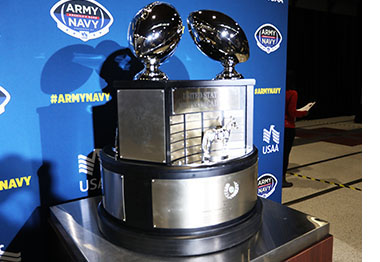
The Commander-In-Chief’s Trophy is awarded to the season’s winner between three of the United States Military Academies — U.S. Military Academy at West Point (Army), U.S. Naval Academy, and U.S. Air Force Academy. The coveted trophy only dates back to 1972, when former Air Force Academy Athletic Director Gen. George B. Simler came up with the idea in effort to create an annual series between all three schools. Prior to 1972, only Army and Navy met every year, with the Air Force playing Army in odd years and Navy in even years.
Trophy Victories
- Air Force – 21
- Navy – 17
- Army – 10
With the Navy's 31-13 win over Army, the Midshipmen took control of the Commander-in-Chief’s trophy, reclaiming it from the Black Knights. Both teams earned wins over Air Force this season, leaving the Falcons out of the hunt. Navy beat Air Force 34-7 on Oct. 5, and Army defeated the Falcons 20-3 on Nov. 2.
A Tie and the Title
Football games that end in a tie are usually disappointing, but that wasn’t the case in the Nov. 27, 1926, Army-Navy game at Soldier Field in Chicago. Navy entered the game undefeated, and Army’s only loss that season was to Notre Dame (which was undefeated until a 19-0 loss to Carnegie Tech on the same day). The matchup, which drew a crowd of more than 100,000, would decide the national championship. The Midshipmen jumped out to an early 14-0 lead before the Black Knights rallied to take a 21-14 lead in the third quarter. Navy scored in the fourth and Army missed a late field-goal attempt resulting in a 21-21 tie. Thanks to the Fighting Irish’s shocking loss, Navy became the de facto national champion with no losses and one tie.
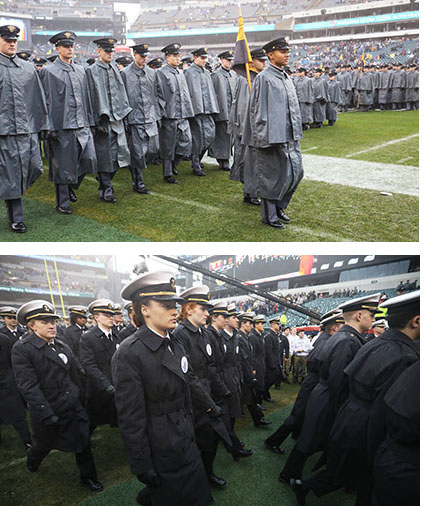
Biggest Margin of Victory in the Series
On Dec 1, 1973, Navy routed a beleaguered Army team 51-0 in Philadelphia. The Midshipmen weren’t having a great season, having only won three games heading into the matchup, but that was three more than the Black Knights. Cleveland Cooper, the first Black player on Navy’s football team, rushed for 102 yards and scored three touchdowns in the victory, helping the Midshipmen improve to 4-7, while Army ended the season 0-10. Navy jumped out to such an early lead that then-coach George Welsh played all 59 players suited for the game.
Navy’s Win Streak, Army’s Skid Comes to End
On Dec. 10, 2016, for the second year in a row, the final score of the Army-Navy game was 21-17, but for the first time in 15 seasons, the Black Knights finished on top. The last time Army had beaten Navy was a 26-17 victory in 2001 before enduring the longest skid by either service academy in series history. The win gave the Black Knights a 7-5 regular season record, and Army advanced to a bowl game for the first time since 2010. The Midshipmen ended the regular season with an impressive 9-4 record and a trip to the Armed Forces Bowl, but that likely didn’t erase the sting of losing to their biggest rival after a 14-game winning streak in the series.
New Conference Connection
|
ARMY VS. NAVY: AT A GLANCE |
|
2024 Season
|
|
Animal Mascots
|
|
Fight Song
|
|
Heisman Trophy Winners
|
For the first time in the teams’ football history, Army and Navy will face off as members of the same conference, the American Athletic Conference (AAC). Although Navy has been an AAC member since 2015, the conference added Army football in 2024. The Dec. 14 game won’t count toward a conference victory because the AAC agreed to keep the rivalry separate, meaning the teams won’t meet as conference foes during the regular season. However, the two teams could still meet in the conference championship in the future if both finish at the top of the conference standings at the end of the regular season. If such a scenario occurred, Army and Navy would play twice that year – in the conference championship and in their regularly scheduled rivalry postseason matchup. In its first year in the conference, Army won AAC title with a 35-14 victory over Tulane in the championship game Dec. 6.
Army-Navy Game Uniforms
While fashion may not be the first thing that comes to mind when thinking about football, the Army-Navy game uniforms are certainly worth a look.
For more than a decade, the two teams have often worn “alternate” uniforms, designed specifically for this special rivalry.
Over the years, Army players have honored the 1st Infantry Division with an all-black design; boasted digital camo pants; wore all-white uniforms and a skiing panda on their cleats to honor the World War II Pando Commandos; and donned matte-finish helmets featuring the symbols of the Army Division each player will serve in after graduation.
Not to be outdone, Navy has had some dazzling duds over the years as well, including unis paying homage to longtime mascot Bill the Goat; red-and-white stripes adorning mostly blue uniforms and helmets; shiny blue, multi-dimensional helmets embellished with different Naval vessels; and vibrant blue unis and helmets with yellow striping that honored the Blue Angels.
New Uniforms for 2024
Both teams recently revealed their 2024 looks, and they don’t disappoint in the fashion department.
Navy will honor the Jolly Rogers, an aviation unit established in 1943. Their tagline is “Fear the Bones,” and their call sign is “Victory.” To pay homage to this legendary aviation unit, Navy’s uniforms will feature the famed tagline in the interior collar. The color of the uniform is white, with black accents highlighted by yellow striping, mimicking the look of the Jolly Rogers aircraft, and the neck of the uniform will boast the Jolly Rogers’ insignia and a dark Navy-blue color. The jersey nameplate and numbers resemble the lettering on the aircraft, and the pants pay tribute to the six squadrons that earned the Jolly Rogers nickname throughout the years. Of course, the helmet will feature the unit’s iconic skull and crossbones logo.
Army will be honoring the 101st Airborne Division, specifically the “Screaming Eagles” role in the Battle of the Bulge and the defense of Bastogne. The Black Knights’ helmets will boast different markings the 101st Airborne used to identify its specific units, known as the card suits (spades, hearts, clovers, diamonds). The uniforms and helmet are black coated with a “snow” effect. The patch of an Invasion Star is located on the front left shoulder above the word “Bastogne.” The nameplate lettering on the back of the jerseys mimics old typewriter style. The design is a nod to Army Gen. Anthony McAuliffe’s infamous “Nuts!” response when asked by the Nazis to surrender. The front of the black helmets will boast the bald eagle insignia “Old Abe,” resembling the patch of the 101st Airborne, which led to the unit’s moniker of Screaming Eagles.
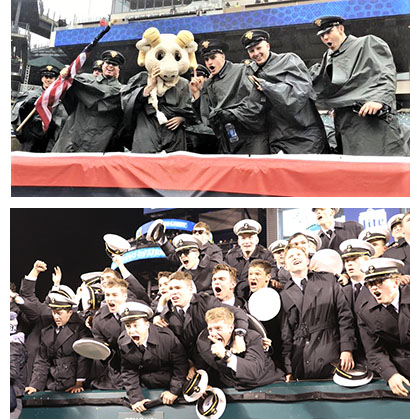
Traditions, Fanfare, and Festivities
A lot of the excitement and fervor surrounding the annual Army-Navy game has little to do with what’s happening on the playing field. The buildup around the game is almost as big as the game itself. There are the time-honored traditions, such as:
- “March-On.” The student bodies of both academies take the field in uniform prior to the game to display their precision and skill in concise formations.
- “Honoring the Fallen.” Both teams sing each other’s alma mater to the fans after the game as a show of respect.
- The “prisoner exchange.” Seven West Point students and seven students of the USNA are returned to their respective schools after spending a semester at their rival academy.
- “Spirit Spots.” This might be a relatively newer tradition, but it often receives the most attention before kickoff. Spirit spots are videos that take #GoArmyBeatNavy and #GoNavyBeatArmy to new and hilarious heights. The spoof videos are generally used to taunt the opponent and often feature entertaining parodies, creative storylines starring West Point and USNA students and/or graduates, and no shortage of mules and goats. While plenty of other schools do spirit videos and Navy produces spirit spots against other opponents, the Army-Navy spirit spots — much like the game itself — are in a league of their own.
| LOOKING BACK AT THE LAST 10 YEARS |
|
Dec. 14, 2024: Navy 31, Army 13 Dec. 9, 2023: Army 17, Navy 11 Dec. 10. 2022: Army 20, Navy 17 (OT) Dec. 11, 2021: Navy 17, Army 13 Dec. 12, 2020: Army 15, Navy 0 Dec. 14, 2019: Navy 31, Army 7 Dec. 8, 2018: Army 17, Navy 10 Dec. 9, 2017: Army 14, Navy 13 Dec. 10, 2016: Army 21, Navy 17 Dec. 12, 2015: Navy 21, Army 17 |
Army-Navy Game in Pop Culture
During the inaugural season of the hit TV show M*A*S*H, an episode centered around a fictional Army-Navy game. In the episode, which originally aired Feb. 25, 1973, a buzz about the game is circulating around the 4077th, with members of the Army medical unit betting on the game. As the game begins, the camp is attacked by enemy fire. During the attack, an unexploded shell lands in the middle of the compound and members of the unit scramble to try to find out who the bomb belongs to. When Hawkeye calls headquarters to seek assistance, a preoccupied Col. Hersh tells Hawkeye to find out if the bomb is still ticking, check the casing for markings, and report back to get instructions on how to defuse it — preferably at halftime. The unit’s commander, Lt. Col. Blake, relays the markings to Col. Hersh, who verifies it’s not an enemy bomb, or an Army device, and suggests Blake call the Navy. When asked, “Why would the Navy drop a bomb on us?”, Hersh responds, “because we’re beating them 14 to nothing.” Later, Hawkeye and crew receive reports from the Navy that the bomb belongs to the CIA. After a mix-up with dismantling instructions, the “propaganda bomb” detonates, filling the compound with harmless leaflets. The episode ends with an announcement of the final score: Navy 42, Army 36. Father Mulcahy, who initially wasn’t interested in participating in the betting pool and was disappointed to learn the game didn’t feature Notre Dame, won the $1,000 purse.
Contact: Paris Moulden, Public Relations, pmoulden@woundedwarriorproject.org, 904.570.7910
About Wounded Warrior Project
Since 2003, Wounded Warrior Project® (WWP) has been meeting the growing needs of warriors, their families, and caregivers — helping them achieve their highest ambition. Learn more about Wounded Warrior Project.
